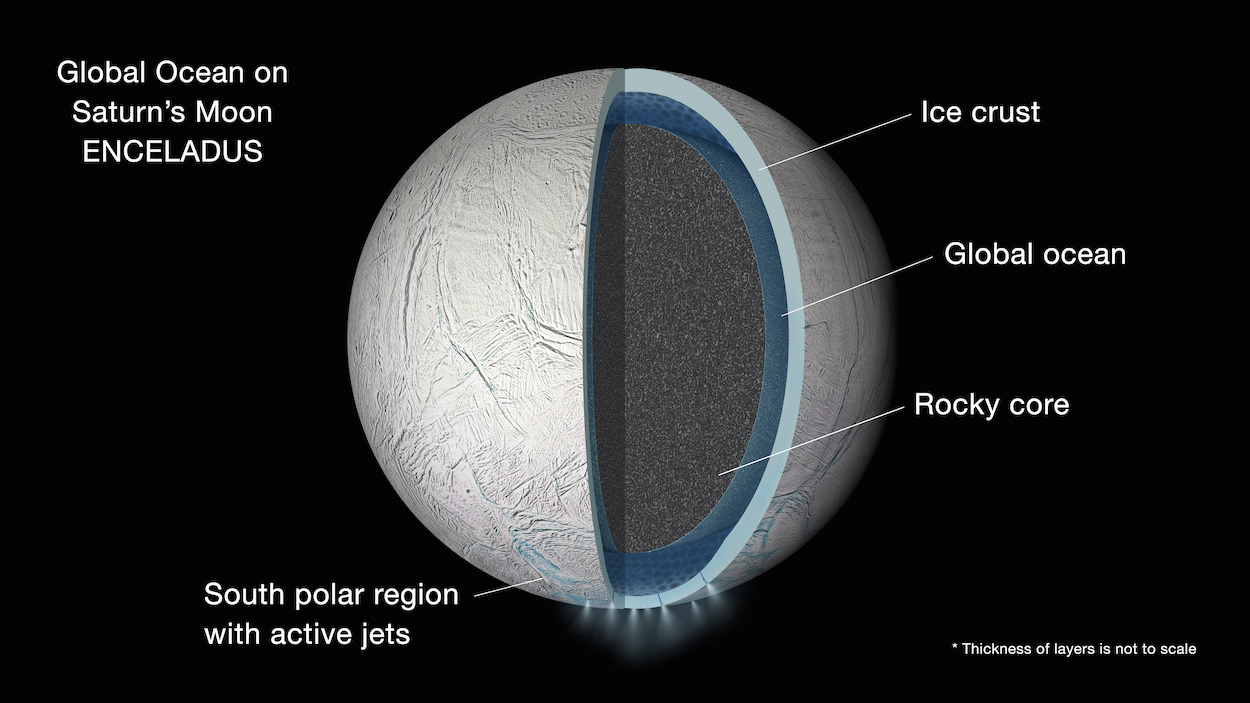
Along with Jupiter’s moon Europa, Saturn’s moon Enceladus is considered to be one of the best places to look for evidence of life elsewhere in the Solar System, since both moons are now known to have liquid water beneath their icy surfaces. Now, new evidence suggests that Enceladus may be an even better candidate than first thought: data from the Cassini orbiter shows that the moon harbors a global ocean of water beneath the ice crust, just like Europa, instead of a smaller sea beneath the south pole as previously believed.
The new research has been published this week in the journal Icarus.
Huge jets of water vapor erupting from the moon’s south pole suggested subsurface liquid water was present and additional evidence indicated the presence of a lens-shaped sea beneath the south polar ice. Other evidence, however, pointed to a possible global ocean, not just a smaller sea, and these newest results confirm that.
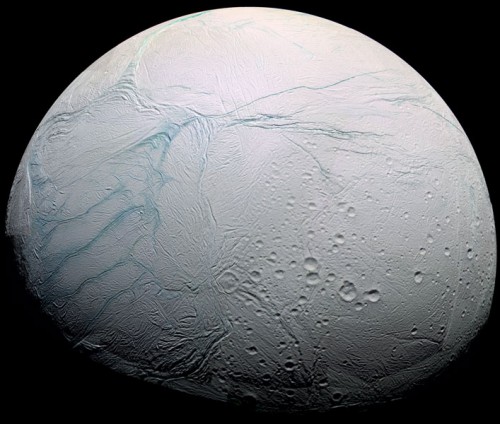
Enceladus exhibits a very slight wobble as it orbits Saturn, and analysis of that wobble indicates that the outer ice shell is not frozen solid to the inner rocky core, which scientists say means there is a global layer or ocean of water between the ice shell and the core, similar to what is found on Europa.
“This was a hard problem that required years of observations, and calculations involving a diverse collection of disciplines, but we are confident we finally got it right,” said Peter Thomas, a Cassini imaging team member at Cornell University, Ithaca, New York, and lead author of the paper.
The results come from analysis of both gravity data and images sent back by Cassini over the past seven years. By carefully mapping the positions of features on Enceladus, such as craters, across hundreds of images, scientists were able to measure changes in the moon’s rotation with extreme precision. They found that the moon has a tiny but measurable wobble, called a libration, caused by Saturn’s gravitational pull. The wobble occurs since Enceladus is not perfectly spherical and it goes slightly faster and slower during different portions of its orbit around Saturn.
“If the surface and core were rigidly connected, the core would provide so much dead weight the wobble would be far smaller than we observe it to be,” said Matthew Tiscareno, a Cassini participating scientist at the SETI Institute in Mountain View, Calif., and a co-author of the paper. “This proves that there must be a global layer of liquid separating the surface from the core.”
The team had studied different computer models to see which one best fit the observations, and the one that did was the global ocean model.
“This is a major step beyond what we understood about this moon before, and it demonstrates the kind of deep-dive discoveries we can make with long-lived orbiter missions to other planets,” said co-author Carolyn Porco, Cassini imaging team lead at Space Science Institute, Boulder, Colo. “Cassini has been exemplary in this regard.”
Previous research has also provided evidence for current hydrothermal activity on the sea/ocean bottom of Enceladus, similar to that seen on Earth. In Earth’s oceans, those places can be oases for a wide variety of lifeforms; whether the same is true for Enceladus is of course still unknown, but the new findings certainly strengthen the possibility.
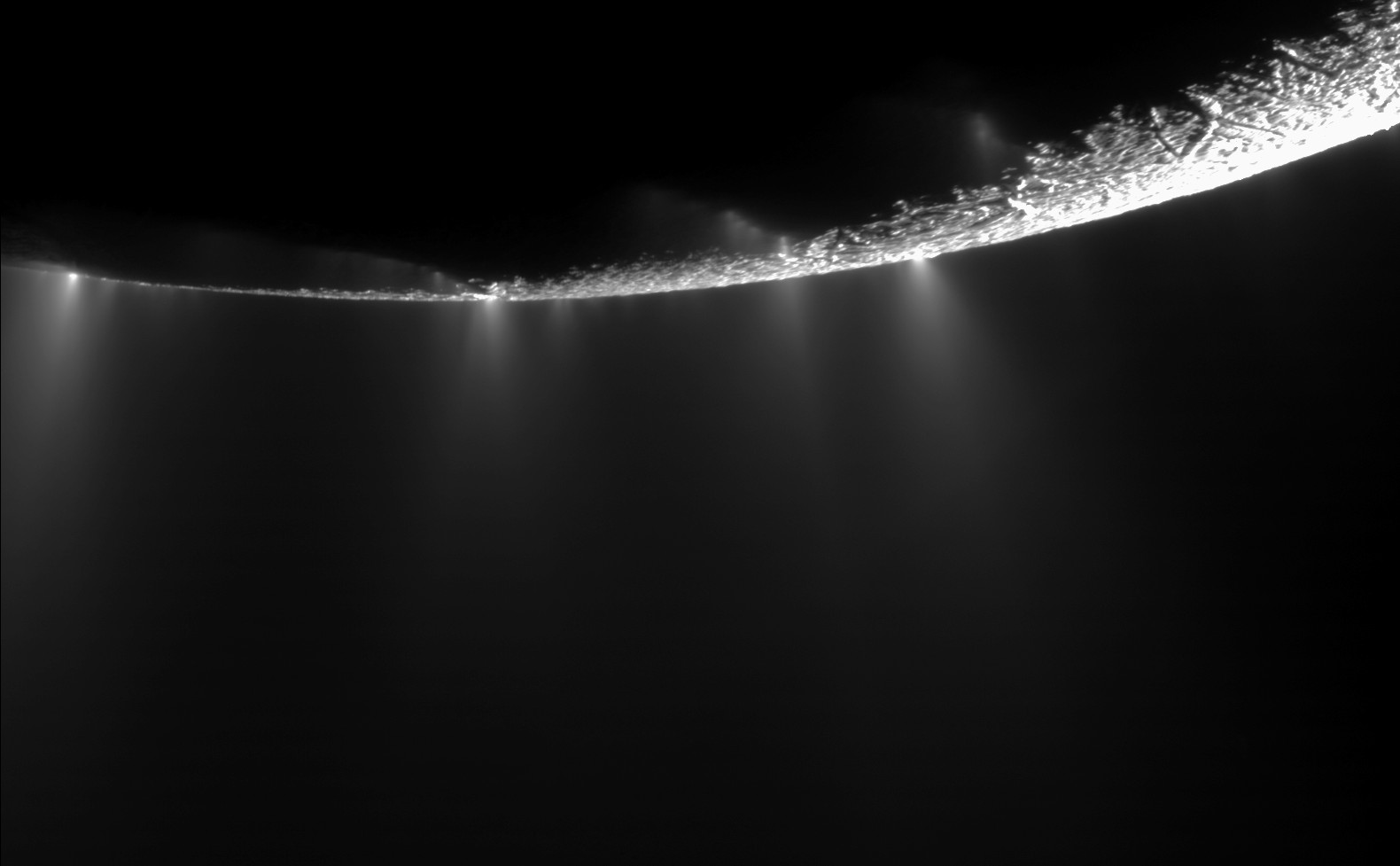
Cassini has also analyzed material in the jets by flying directly through them, and found the plumes to contain water vapor, ice particles, sodium, potassium, methane, carbon monoxide, carbon dioxide, nitrogen, and both simple and complex organics. Organics by themselves don’t prove there is life in the waters below, and Cassini isn’t equipped to directly identify living things, but they do show, along with the salts, rocky core, and heat, that the ingredients for life are there. There is enough heat (and salts) for the water to remain liquid and the rocky core could provide the chemical nutrients needed by any putative life forms, just as happens on Earth. Some other moons such as Jupiter’s moon Ganymede are considered less likely to support life even though they also have subsurface oceans, because there is no connection between the rocky core and the water; the ocean is instead sandwiched between layers of ice.
Cassini will make another dive through Enceladus’ plumes on Oct. 28, 2015, passing only 30 miles (49 kilometers) above the moon’s surface. While massive in size, the plumes are diffuse, so there is little or no danger to the spacecraft.
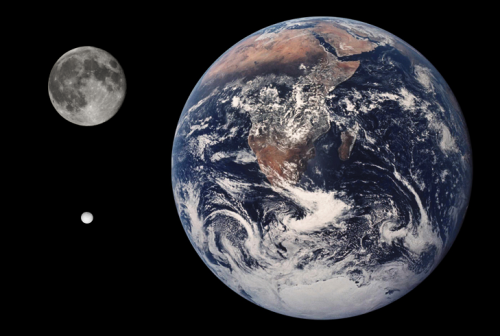
It is still not known exactly how Enceladus’ ocean remains liquid beneath the ice crust, but tidal forces from Saturn’s gravity are considered a strong possibility. As would be expected, Enceladus is freezing cold on the surface, being so far from the Sun. The results are also surprising since Enceladus is so small, only 313 miles (504 kilometers) in diameter. There are also thought to be smaller “lakes” of salty water within the ice crust, below the surface but above the ocean.
The fact that Enceladus is already known to be a geologically active moon, plus the existence of a global ocean, makes it an even more attractive target for future exploration. Future spacecraft to return to this amazing world are now on the drawing boards, and they could also the plumes, but this time looking specifically for any evidence of biological activity. One such mission being considered is the Enceladus Life Finder (ELF) which would fly through and sample the plumes similar to how Cassini has. From the paper:
“Is there life elsewhere in the solar system? This simple question is one of the motivators for the exploration of our solar system. Guided by the principle that we can most easily recognize life as we know it – life that requires liquid water – three extra- terrestrial environments are commonly called out as candidates for hosting life today: the deep crust of Mars, the subsurface ocean of Europa, and an ocean within Enceladus. Of these three, Enceladus is particularly attractive because liquid water from its deep interior is actively erupting into space, making sampling of the interior straightforward. The Cassini Saturn Orbiter has demonstrated the feasibility of such sampling by making in situ measurements with relatively low-resolution mass spectrometers.”
Enceladus Life Finder would be a great way to further study Enceladus at a relatively inexpensive cost, and learn about processes occurring inside the moon, in the ocean itself in particular.
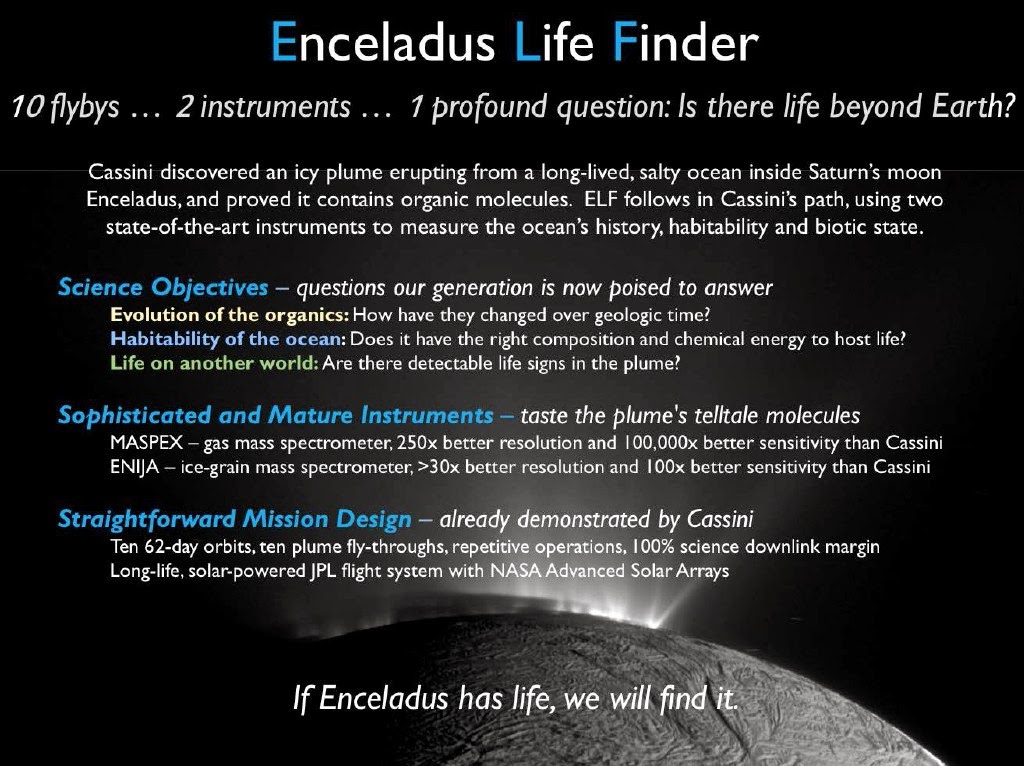
Since the plumes originate from the water below, and erupt through large fissures called Tiger Stripes in the icy surface, they provide an ideal way to search for evidence of life without having to drill through the ice into the water below, a much more difficult and farther-off prospect. If any microorganisms or other biological matter were present in the water, they could easily be ejected into space through the plumes. In this sense, Enceladus would be easier to explore than Europa, even though it is much farther away.
With an entire ocean to study, Enceladus is a world begging to be explored further, and maybe, just maybe, will help answer age-old questions about how life originated on Earth and how common it may be elsewhere.
More information about the Cassini mission is available here and the Enceladus Life Finder mission here.
Want to keep up-to-date with all things space? Be sure to “Like” AmericaSpace on Facebook and follow us on Twitter: @AmericaSpace





Imagine how Carl Sagan would have been excited about this mission had he known about the subsurface ocean!
Just wondering… If you take a bottle of our ocean water, freeze the top and subject it to a cold vacuum, crack open the ice and let water fizz out similar to Enceladus; then scoop up some of the stuff: would it be possible to detect the microbes which lived in that water by using a microscope and actually SEE them?